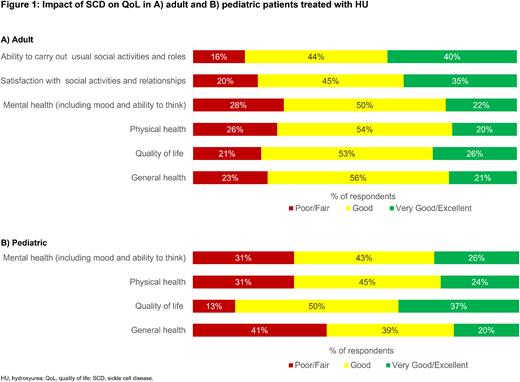Abstract
The prevalence of SCD in the Kingdom of Saudi Arabia (KSA) is one of the highest in the world with up to 2.6% of the population affected. The Real-World Assessment Survey for Sickle Cell Disease in Saudi (ROARS) was conducted to evaluate the impact of SCD on the quality of life (QoL) of this population. Here, we present data on the QoL burden experienced by patients with SCD in KSA treated with hydroxyurea (HU).
Between September and December 2021, patients in KSA with SCD (age: 5-65 years) were surveyed (caregivers were surveyed for patients 5-14 years) using structured, bilingual ROARS questionnaires (English/Arabic) through personal quantitative web-assisted telephone interviews. The survey includes the Patient-Reported Outcomes Measurement Information System (PROMIS) global health domain, a validated tool for assessing QoL among SCD patients and caregivers. The survey evaluated topics such as the impact of SCD on QoL, symptoms, impact of SCD on productivity at work/school, and treatment goals.
A total of 1011 responses to the survey were collected; of these, 32.3% (n=327) of patients were currently being treated with HU (47% of adult and 17% of pediatric patients surveyed) and are the focus of this analysis. Amongst these patients, the median age (range) was 25 (5-83) years. Patients were responsible for reporting their SCD genotype: 58% of respondents were diagnosed with HbSS (n=189), 26% with HbSC (n=86), 2% with HbSβ0 thalassemia (n=8), and 5% with HbSβ+ thalassemia (n=15). Overall, 35% (adults, n=84; pediatric n=25) of patients in the eastern province were treated with HU, 27% (adult, n=71; pediatric, n=17) in the western province, 24% (adult, n=55; pediatric, n=24) in the southern province, and 14% (adult, n=29; pediatric, n=22) in the central province. Among HU-treated patients, 64% reported never ceasing/stopping treatment, 21% rarely ceased/stopped treatment and 15% of patients cease/stop treatment sometimes, often, or all the time. The most common reason for patients ceasing/stopping treatment was forgetting to take their medication (79%). Of patients who cease/stop treatment sometimes, often, or all the time (n=48), 17% of these stated that their medication was not available while 4% could not afford their medication.
The mean (SD) number of VOCs reported by HU-treated patients in the 12 months prior to survey completion was 4.6 (4.09), while 32% (n=104) of these patients reported experiencing ≥5 VOCs in the same period. The most common SCD symptoms (other than VOCs) experienced by HU-treated patients were bone ache (reported by 92% of respondents), fatigue/tiredness (85%), headache (79%), anxiety (61%), joint stiffness (56%) and numbness/tingling (51%). Most HU-treated patients reported poor/fair or good health for all QoL metrics assessed (Figure 1). Almost half of patients (49%) reported that their SCD was impactful/extremely impactful on their emotional wellbeing.
Of those treated with HU, 71% of patients reported that HU is effective in treating their SCD symptoms. However, 84% of patients report a desire for alternatives to their current pain management medication while 72% report concerns about the long-term side effects of HU. The most important treatment goals for these patients were improvement in quality of life (82%), improvement in overall symptoms (79%), and reduction in the number of severe pain crises and increase in the number of days free from severe pain crises (79%). A total of 48% of HU-treated patients were bothered by limitations in performing everyday activities; 48% and 55% of patients also reported that their SCD has prevented them from progressing in their career or education, respectively. Patients treated with HU reported missing a mean (SD) of 6.9 (10.4) hours of work in the 7 days prior to survey completion because of their SCD.
Access to HU treatment continues to be a challenge, with approximately 70% of patients surveyed not receiving HU. Despite the observed clinical benefit in symptom control, patients receiving HU continue to experience disease burden including substantial impact on QoL and productivity at work/school (as evident from the treatment goals identified by patients). These data highlight the necessity of optimizing HU accessibility and treatment strategies to improve patient outcomes. These data also illustrate the need for novel therapeutic options and management strategies for patients with SCD to target patient-reported treatment goals.
Disclosures
Al Zayed:Novartis: Honoraria, Other: Meeting/travel support. Al Darwish:Roche: Consultancy, Honoraria; Amgen: Consultancy, Honoraria, Other: Meeting/travel support; Novartis: Consultancy, Honoraria, Other: Meeting/travel support; Elsevier: Honoraria. Tarawah:Novo Nordisk: Honoraria, Other: Meeting/travel support; Sobi: Honoraria, Other: Meeting/travel support; Novartis: Honoraria, Other: Meeting/travel support; Takeda: Honoraria; Roche: Honoraria. Al Manea:Novartis: Consultancy. Alhazmi:Sanofi: Consultancy, Honoraria; Novartis: Consultancy, Honoraria. Alzahrani:GILEAD: Other: Meeting/travel support; Novartis: Consultancy, Other: Meeting/travel support; MSD: Honoraria. Soliman:Novartis: Current Employment. Askar:Novartis: Current Employment. Yassin:Novartis: Current Employment. Jastaniah:Roche: Consultancy, Honoraria; Elsevier: Honoraria; Amgen: Consultancy, Honoraria, Other: Meeting/travel support; Novartis: Consultancy, Honoraria, Other: Meeting/travel support.
Author notes
Asterisk with author names denotes non-ASH members.


This feature is available to Subscribers Only
Sign In or Create an Account Close Modal